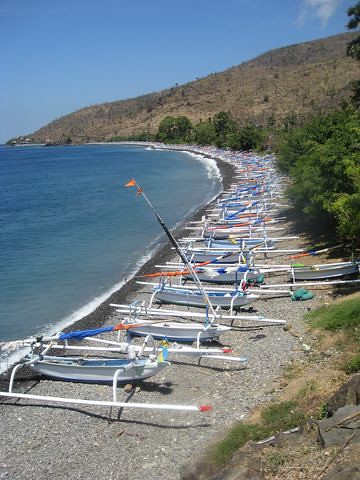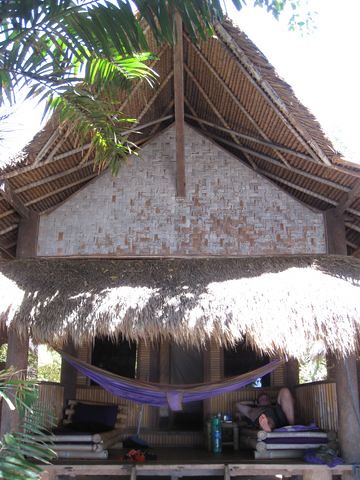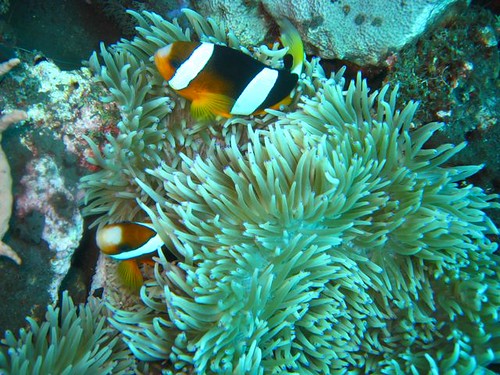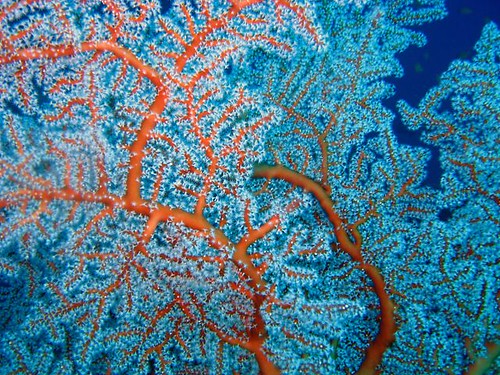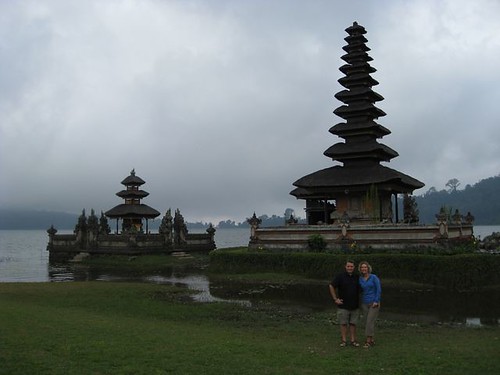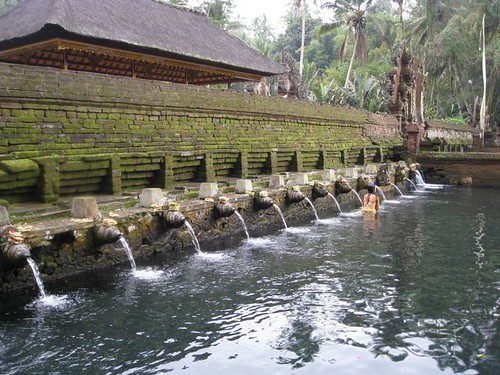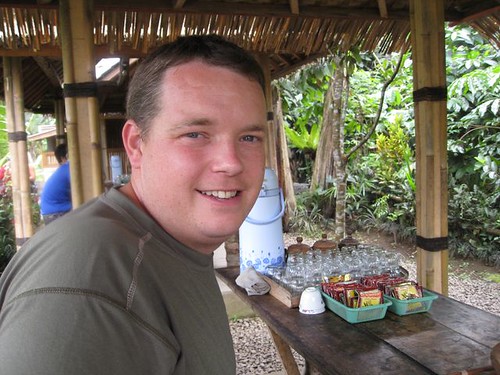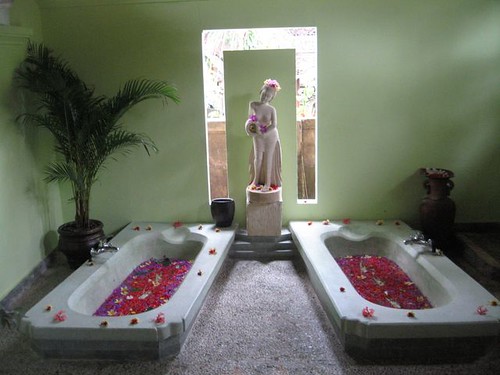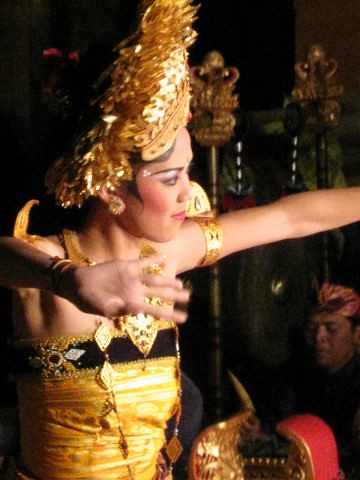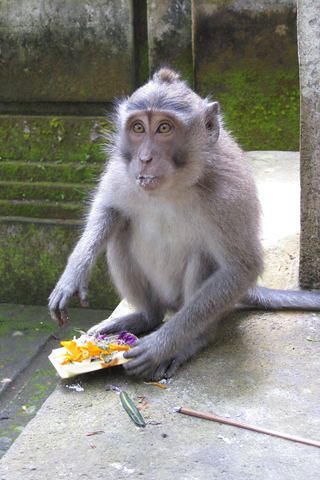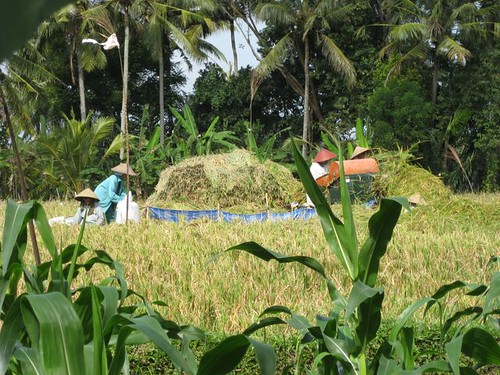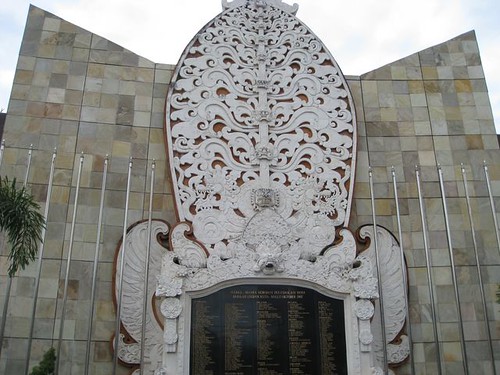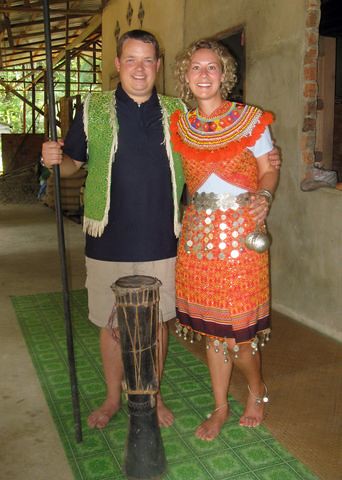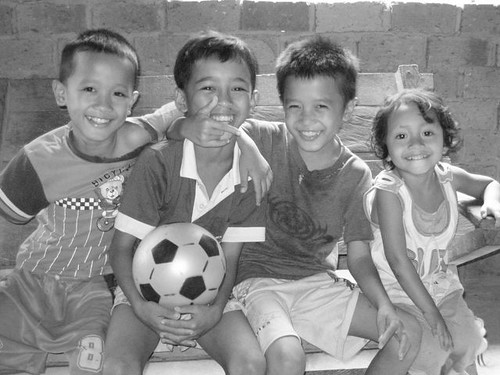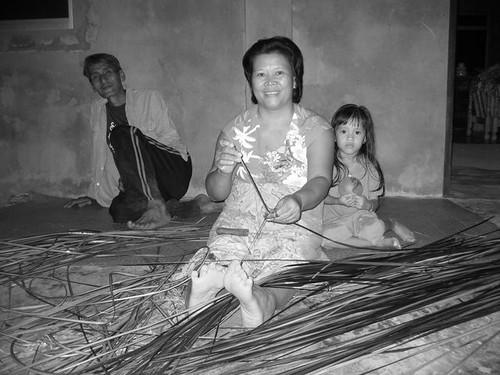Destination: Nusa Lembongan
Number of Days there: 7 days
Our Best of: Two mola mola sightings; chilling at the "free" pool; how incredibly chill the island was despite (or because of) the whole surfer crowd
One thing unexpected: Seeing the mola mola up close and personal with no other divers present.
Times we took the: Bus: 0 Train/Subway: 0 Taxi/Car: 0; Motorcycle: 5; Boat: 4
Estimated KM walked: Around 16km
Where we stayed: Aussie owned Linda's - Rp 100,000 (US $10)
Likes: Cheap price, very clean, friendly staff, and met some great fellow travelers in Rosalie (Dutch) and Adam (English).
Dislikes: Rather bland food, which is typical of Western establishments; last hotel on the beach strip so the walk to the middle was quite far each day.
 Favorite Restaurant: Mangrove Restaurant - Jacketfish - RP 50,000 ($5) & Grilled Tuna - RP 35,000 ($3.50). Quiet little restaurant about a 40 minute walk from town (10 minutes by motorbike, free pickup). We had this awesome place all to ourselves all three nights we went, other than the crazy Aussie that made this place his home while on holiday. The little shop with the nasi campur in paper bags - RP 4,000 ($.40) was not only cheap, but delicious as well!
Favorite Restaurant: Mangrove Restaurant - Jacketfish - RP 50,000 ($5) & Grilled Tuna - RP 35,000 ($3.50). Quiet little restaurant about a 40 minute walk from town (10 minutes by motorbike, free pickup). We had this awesome place all to ourselves all three nights we went, other than the crazy Aussie that made this place his home while on holiday. The little shop with the nasi campur in paper bags - RP 4,000 ($.40) was not only cheap, but delicious as well!
What we did:

 We arrived mid morning and made made our rounds of hotels before settling on Linda's. We are starting to get the hang of finding cheap hotels. Instead of just settling on the first one that looks nice, we set the bags down, and one of us scopes out what is available. After finding the hotel, Tracy struck out to talk to the dive shops about diving. Since World Divers was booked (the one most highly recommended) we settled on Bali Dive Academy, which also happened to be a 5 star PADI dive shop as well and was recommended by World Divers. After meeting the French instructor, Severina, we decided to go ahead and complete our PADI Advanced Open Water with four dives: Deep Dive (between 20 and 40 meters), Drift Dive (where you just ride the wave underwater, hopefully), Underwater Navigation (Break out the compass and start counting fin strokes!) and Peak Buoyancy Control (practice doing push ups using only your lungs). After getting our dives set up, we started to walk over to the beach when we passed this quite little hotel on the hill. We poked our heads in and saw paradise. The pool was deserted and the view was tremendous. We strolled up to the counter and after a few words
We arrived mid morning and made made our rounds of hotels before settling on Linda's. We are starting to get the hang of finding cheap hotels. Instead of just settling on the first one that looks nice, we set the bags down, and one of us scopes out what is available. After finding the hotel, Tracy struck out to talk to the dive shops about diving. Since World Divers was booked (the one most highly recommended) we settled on Bali Dive Academy, which also happened to be a 5 star PADI dive shop as well and was recommended by World Divers. After meeting the French instructor, Severina, we decided to go ahead and complete our PADI Advanced Open Water with four dives: Deep Dive (between 20 and 40 meters), Drift Dive (where you just ride the wave underwater, hopefully), Underwater Navigation (Break out the compass and start counting fin strokes!) and Peak Buoyancy Control (practice doing push ups using only your lungs). After getting our dives set up, we started to walk over to the beach when we passed this quite little hotel on the hill. We poked our heads in and saw paradise. The pool was deserted and the view was tremendous. We strolled up to the counter and after a few words 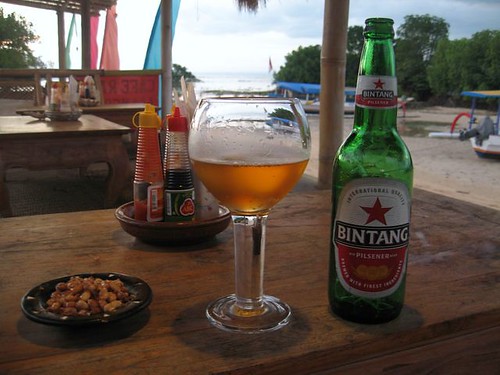 back in forth (are you SUUUURE we can't use the pool if we buy a drink???) they reluctantly said ok. I always wondered why people would ever go to the beach and get in a pool, but that day, I saw why. We spent the rest of the day sipping on Bintang Beer, dipping in and out of the clean, clear waters of the infinity pool to cool ourselves and just relaxing the day away while enjoying the view. After returning to the hotel, Rosalie, a traveler from Holland, has told us about this amazing place called Mangrove and that we had to go and try the Jacket Fish. After just finishing our blah meal at Linda's, we told her to count us in for the next night!
back in forth (are you SUUUURE we can't use the pool if we buy a drink???) they reluctantly said ok. I always wondered why people would ever go to the beach and get in a pool, but that day, I saw why. We spent the rest of the day sipping on Bintang Beer, dipping in and out of the clean, clear waters of the infinity pool to cool ourselves and just relaxing the day away while enjoying the view. After returning to the hotel, Rosalie, a traveler from Holland, has told us about this amazing place called Mangrove and that we had to go and try the Jacket Fish. After just finishing our blah meal at Linda's, we told her to count us in for the next night!
 The first two dives were the more technical ones, Peak Buoyancy and Underwater Navigation. The dive shop had warned us that the water was cold. We thought to ourselves, "It's the tropics, how cold could it really be?" After jumping in the water, we soon found out! Where the average water temperature of most dive sites are around 75-80 degrees, this particular dive site sat at a balmy 55-60 degrees. We later found out that the waters between Bali and the island are home to one of the deepest trenches in the world and sits directly on a fault line. The 20 degrees difference is do to the swells from down below. After practicing our hovering and push ups underwater we took a small break and were back in the water for the Navigation Course. Given that I had pretty much failed the compass part in our Open Water classes I was not
The first two dives were the more technical ones, Peak Buoyancy and Underwater Navigation. The dive shop had warned us that the water was cold. We thought to ourselves, "It's the tropics, how cold could it really be?" After jumping in the water, we soon found out! Where the average water temperature of most dive sites are around 75-80 degrees, this particular dive site sat at a balmy 55-60 degrees. We later found out that the waters between Bali and the island are home to one of the deepest trenches in the world and sits directly on a fault line. The 20 degrees difference is do to the swells from down below. After practicing our hovering and push ups underwater we took a small break and were back in the water for the Navigation Course. Given that I had pretty much failed the compass part in our Open Water classes I was not 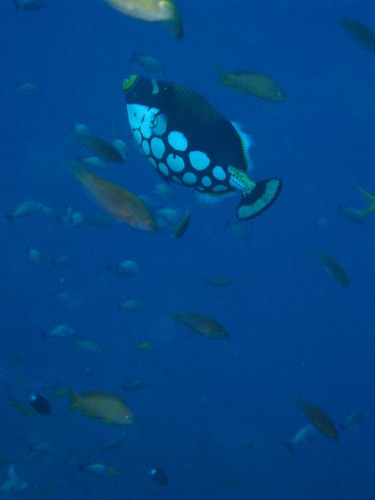 looking forward to breaking them out one more time. Not only did we have to make a square using a compass underwater, but we also had to measure how many fin stokes it takes to travel a predetermined distance. Swimming back and forth, back and forth, making squares, navigating around rocks can really wear you out, not to mention make your air rapidly disappear. As Tracy was completing her "perfect" square, I looked down and realized I was sitting on 60 bars and still had to complete my square. Much to my delight, Instead of the standard 20 fin stroke square, mine was reduced to 8 fin strokes! This is one of the only times that it pays to be a heavy breather! We resurfaced without incident, and looked forward to some real diving the next day. We raced back to the hotel just in time to be picked up by motorbike to be taken to Mangrove. The ride itself was good fun, poor road combined with night made for a bumpy and slightly scary ride. We ordered a couple of Bintang's and the infamous Jacketfish along with Rosalie and Adam. As the fish arrived, I actually recognized the fish as one of the fish that are prevalent on the reefs. Thinking to myself that I had seen countless ones all over the reef, I found a little comfort in knowing they were by no means endangered, no matter how pretty they are. The texture was moist and flaky, the taste was mild and after adding a little sambal to complete the dish, it was one of the best meals we had had on the trip so far.
looking forward to breaking them out one more time. Not only did we have to make a square using a compass underwater, but we also had to measure how many fin stokes it takes to travel a predetermined distance. Swimming back and forth, back and forth, making squares, navigating around rocks can really wear you out, not to mention make your air rapidly disappear. As Tracy was completing her "perfect" square, I looked down and realized I was sitting on 60 bars and still had to complete my square. Much to my delight, Instead of the standard 20 fin stroke square, mine was reduced to 8 fin strokes! This is one of the only times that it pays to be a heavy breather! We resurfaced without incident, and looked forward to some real diving the next day. We raced back to the hotel just in time to be picked up by motorbike to be taken to Mangrove. The ride itself was good fun, poor road combined with night made for a bumpy and slightly scary ride. We ordered a couple of Bintang's and the infamous Jacketfish along with Rosalie and Adam. As the fish arrived, I actually recognized the fish as one of the fish that are prevalent on the reefs. Thinking to myself that I had seen countless ones all over the reef, I found a little comfort in knowing they were by no means endangered, no matter how pretty they are. The texture was moist and flaky, the taste was mild and after adding a little sambal to complete the dish, it was one of the best meals we had had on the trip so far.
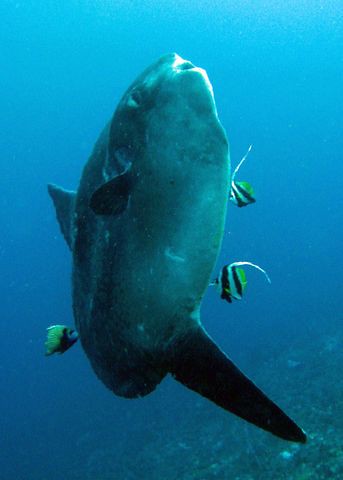 The following day, we started with Crystal Bay, our planned deep dive class. After swimming for about 10 minutes and descending to a depth of around 30 meters (a little over 90 feet) off in the dark depths came a huge fish, the infamous Mola Mola (Sunfish). Measuring about 10 feet long and 6 feet wide, the large fish swam effortlessly towards us as we hovered trying to stay motionless in the water. The Mola Mola lives in the deep waters around 100 meters (300 feet) and far to deep for normal scuba diving. For about three months of the year, they leave there deep home and come to the surface to be cleaned by smaller fish. As the fish came into closer view, we could see the smaller emperor fish picking away at the large fish. We sat and just admired the scenery taking it all in for most of the dive, until we were close to our no decompression limit and had to swim up. Back on the surface, our instructor was ecstatic exclaiming in her French accent "We had zee Mola Mola all to ourselvez!". Indeed, it was her first time seeing one as well, and she had been diving in the area for 3 weeks straight and had yet to see it. After all the excitement, we could not wait to do our drift dive in the afternoon. We had done a drift dive before in Cozumel and remember what a rush it is just flying through the water, letting it take you where it may. As we jumped in the water and dove, we soon realized that the site that is known for current had none! In fact, the water was so calm that we had to swim quite a bit. It was still a pleasant dive site, but we found it a bit ironic that our certification for completing a drift dive would come with no drift what-so-ever. We came back to the hotel, shared our day's excitement with Rosalie and Adam, and got ready for Mangrove, part two (when you find a restaurant you like, stick to it!)
The following day, we started with Crystal Bay, our planned deep dive class. After swimming for about 10 minutes and descending to a depth of around 30 meters (a little over 90 feet) off in the dark depths came a huge fish, the infamous Mola Mola (Sunfish). Measuring about 10 feet long and 6 feet wide, the large fish swam effortlessly towards us as we hovered trying to stay motionless in the water. The Mola Mola lives in the deep waters around 100 meters (300 feet) and far to deep for normal scuba diving. For about three months of the year, they leave there deep home and come to the surface to be cleaned by smaller fish. As the fish came into closer view, we could see the smaller emperor fish picking away at the large fish. We sat and just admired the scenery taking it all in for most of the dive, until we were close to our no decompression limit and had to swim up. Back on the surface, our instructor was ecstatic exclaiming in her French accent "We had zee Mola Mola all to ourselvez!". Indeed, it was her first time seeing one as well, and she had been diving in the area for 3 weeks straight and had yet to see it. After all the excitement, we could not wait to do our drift dive in the afternoon. We had done a drift dive before in Cozumel and remember what a rush it is just flying through the water, letting it take you where it may. As we jumped in the water and dove, we soon realized that the site that is known for current had none! In fact, the water was so calm that we had to swim quite a bit. It was still a pleasant dive site, but we found it a bit ironic that our certification for completing a drift dive would come with no drift what-so-ever. We came back to the hotel, shared our day's excitement with Rosalie and Adam, and got ready for Mangrove, part two (when you find a restaurant you like, stick to it!)
The next day we had told Adam and Rosalie about our little hidden paradise on the hill so we decided to return once again with Adam and Rosalie tagging along. Once again, the friendly staff said ok, and we settled in once again, catching up on some rays (Tracy) and feebly attempting to catch up on this blog (Jason). They also agreed that this was one certainly a pleasant surprise. They had no guests staying at the hotel, and we were their only source of income for the day, so we felt like it was a fair deal.

 We decided that the next day, we had to get in one more day of diving so we actually went to the same place as before for another chance at the Mola Mola. This time we also had "zee Mola Mola all to ourselvez!" As we sat on the side of the cliff just watching, the large fish came closer and closer. We could see its eyes look our way and then look forward. Back and forth his eyes went and closer and closer he came until he was less than three meters away from my head! There is good diving, and then there is once in a lifetime diving, I believe that this moment was one of those once in a lifetime moments. Luckily, Tracy snapped a great photo to capture the moment. As he came within 9 feet, he saw other divers descending upon our location and it made an abrupt turn and swam off to sea. In the afternoon, we did actually do a real drift dive, flying through the water like Superman passing over beautiful coral and passing our little friend, Mr. Jacketfish. Coincidently, the dive site was....The Mangrove.
We decided that the next day, we had to get in one more day of diving so we actually went to the same place as before for another chance at the Mola Mola. This time we also had "zee Mola Mola all to ourselvez!" As we sat on the side of the cliff just watching, the large fish came closer and closer. We could see its eyes look our way and then look forward. Back and forth his eyes went and closer and closer he came until he was less than three meters away from my head! There is good diving, and then there is once in a lifetime diving, I believe that this moment was one of those once in a lifetime moments. Luckily, Tracy snapped a great photo to capture the moment. As he came within 9 feet, he saw other divers descending upon our location and it made an abrupt turn and swam off to sea. In the afternoon, we did actually do a real drift dive, flying through the water like Superman passing over beautiful coral and passing our little friend, Mr. Jacketfish. Coincidently, the dive site was....The Mangrove.
 Our last day, we headed over to spend the whole day at the pool only to discover that "The Boss" was bringing over people from the mainland for the day and it was not possible to use their deserted pool. Now hooked on pools at the beach and dejected, we turned to the resort pool back up the path, Coconut Bay. Sadly, they charge for use of their pool, but at least the pressure to purchase food and beverages was off so we bought our lunch for 4000 (about .40 cents!) and some water somewhere else and hung out all day, albeit far more crowded.
Our last day, we headed over to spend the whole day at the pool only to discover that "The Boss" was bringing over people from the mainland for the day and it was not possible to use their deserted pool. Now hooked on pools at the beach and dejected, we turned to the resort pool back up the path, Coconut Bay. Sadly, they charge for use of their pool, but at least the pressure to purchase food and beverages was off so we bought our lunch for 4000 (about .40 cents!) and some water somewhere else and hung out all day, albeit far more crowded.
After finally deciding on where to head for Tracy's B-day, we boarded the boat in the morning and jumped on a bus heading back to...Ubud, The Return.
A special thanks to momma Karen for your generous gift! It made the sighting of "zee mola mola" possible!





